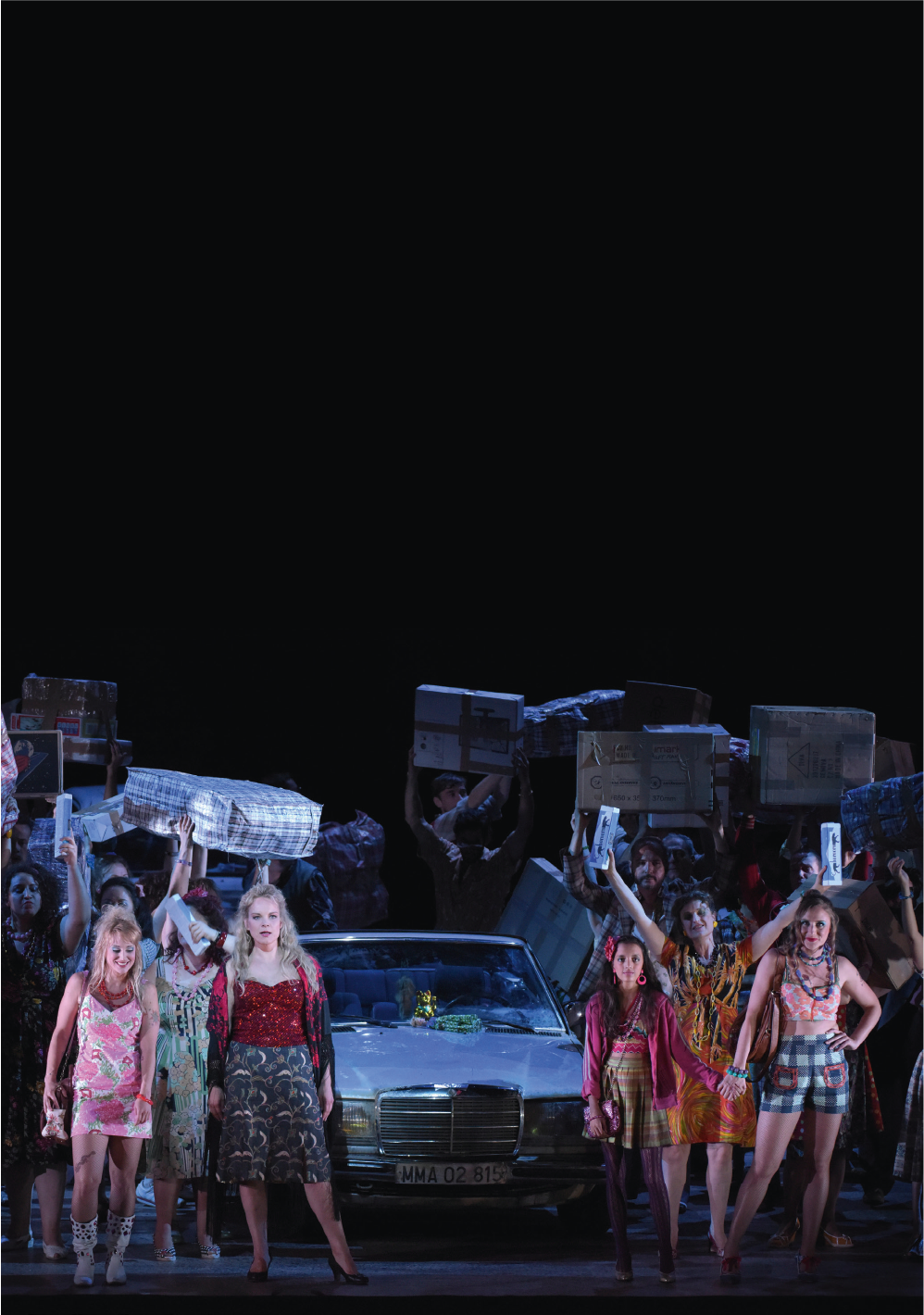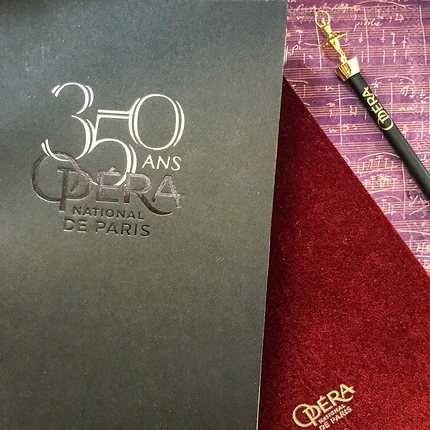With Die Meistersinger von Nürnberg on the bill at Opera Bastille, the musicologist Corinne Schneider has retraced for us the major landmarks in Richard Wagner’s tumultuous idyll with France.
1861: The Tannhäuser debacle
Thanks to
Princess Pauline of Metternich, (wife of the Austrian ambassador) who was on
friendly terms with the Emperor and his wife and who had seen a performance of Tannhauser in Dresden, for the first
time a work by Wagner was to be performed in Paris and by order of Napoleon
III, no less. Resident in Paris for the occasion, Wagner created a French
version of the work with the help of Charles Nuitter (librarian of the Paris
Opera at the time) and modified the 1845 version of the work in various places.
To satisfy the demands of France’s most prestigious opera house, he added a
ballet, which he placed just after the first tableau, instead of including it
in the second act, as was customary in France at the time. After six months of
work and over 160 laborious rehearsals conducted by Pierre-Louis Dietsch with a
despotic Wagner looking over his shoulder, the opening night (13th
March) was greeted with derisive whistling from part of the audience: a claque
had been organised by the Jockey-Club in response to the placing of the ballet.
Parisian high society, that of the Faubourg Saint-Germain, which included a
good number of anti-bonapartites, was involved, the opposition becoming
increasingly political at the second performance on 18th March with
the presence of the Imperial couple. Meanwhile, the press assailed the public
with caricatures and pamphlets on the “music of the future”. Wagner took his
work off the bill after the third performance on March 24th .
Although it was to take three decades before Wagner’s name would again appear
at the Paris Opera, under the Second Empire, a circle of fervent advocates of
his music formed including Baudelaire, Champfleury, Mendès, Pauline Viardot,
Gounod and Pasdeloup who put on Rienzi
at the Théâtre Lyrique in 1869.
1891: Lohengrin, a late consecration
Eine Kapitulation is the title Wagner gave to his 1870 farce, written in
the style of an antique comedy to jeer at the defeat of the French in the
Franco-Prussian conflict. The work was to remain in the Parisian memory for a
long time and constituted a serious obstacle to the performance of Wagner’s
operas in the capital. Long after the composer’s death, the very name of Wagner
was enough to conjure up the spectre of a certain ‘German-ness’ that was far
from welcome in a highly nationalist political context. Lamoureux was obliged
to cancel the remaining performances of Lohengrin
at the Eden-Théâtre after the opening night on 3rd May 1887 was
greeted by an anti-German riot outside the theatre that had to be dealt with by
the police. In tune with the tenor of the political and diplomatic relations
between the two countries, the anti-Wagner faction declared war on the
‘Wagnerophiles’, which by no means deterred the latter from going to the
Bayreuth Festival or rushing to attend concerts of orchestral and operatic
extracts conducted with dogged regularity by Pasdeloup, Lamoureux and Colonne.
Although in 1891 Lohengrin had
already enjoyed over a hundred performances in various other French towns, it
wasn’t until 16th September of the same year that the work finally
appeared on the bill at the Palais Garnier. After 174 rehearsals, with the
Republican Guard surrounding the building in order to counter any Boulangist or
anti-German feeling, the Parisian premier, in Nuitter’s French version, with
Rose Caron and Ernest Van Dyck conducted by Lamoureux was a glittering success
and continued to be performed at the capital’s most prestigious opera house
until 1914. One after the other, Die
Walküre (1893), Tannhäuser (1895),
Die Meistersinger von Nürnberg (1897),
Siegfried (1902) and Tristan und Isolde (1904) entered the
repertoire in French translations, without, however, dislodging Lohengrin which remained the most
popular Wagner opera at the Paris Opera, with a total of 327 performances from
1891 to 1914.
1911: From the first tetralogy to Parsifal with André Messager
Despite
their late entry to the Paris Opera repertoire, between 1875 and 1914, a total
of nine works by Wagner were performed, more than by any other composer,
beating Massenet with seven, Saint-Saëns with five and Gounod and Verdi with
four each. As soon as he took up his post as co-director at the Palais Garnier,
André Messager introduced Götterdämmerung
(1908) and Das Rheingold (1909) to the repertoire., Messager had been to
Bayreuth in 1886 to see Parsifal and Tristan , returning in 1888 for Parsifal and Mastersingers and 1896 for
the Ring Cycle and though he never succumbed to ‘Wagnermania’, he was an ardent
defender of Wagner’s works. He made his debut as a Wagnerian conductor in
Marseille where in 1997 he conducted Die
Walküre. It was thanks to his influence that in 1909, the Paris Opera
performed the Tetralogy in its entirety with a French translation in “rhythmic
prose” by Alfred Ernst. In June 1911, Messager invited Felix Weingartner and
Arthur Nikisch to conduct two complete Ring Cycles, one after the other, as it
was performed at Bayreuth, with Das
Rheingold , Die Walküre , Siegfried and Götterdämmerung on 10th,
11th, 13th
and 15th June respectively, the second cycle beginning on 24th
and ending on 29th . A second edition was scheduled the following
year, once again conducted by Weingartner from the 15th to the 20th
of June and by Messager himself from 24th to 3rd July,
omitting Die Walküre. The Golden Age
of Wagner at the Paris Opera culminated on 4th January 1914 with the
French premier of Parsifal in Alfred
Ernst’s translation, in the presence of the President of the Republic. André
Messager was one of the first conductors to take on Wagner’s final opera, a
work on which Bayreuth had enjoyed a twenty-year monopoly which only ended on
31st December 1913. A few months before war broke out, the first Parisian
Parsifal , sublimated by the
performances of Lucienne Bréval, Paul Franz and Marcel Journet, played to full
houses and attained international acclaim.
1932: The Triumph of Wilhem Furtwängler
During
the First World War, Wagner was utterly ostracised. In the aftermath of the
conflict, the capital echoed to the rhythms of the new modernist tendencies,
and performances of Wagner were not revived until 5th January 1921
with Die Walküre, and then not with
the frequency they had enjoyed before the war. A fringe remained faithful to
the Wagnerian repertoire even though the critics complained about the
old-fashioned productions and dusty old pre-war scenery. Throughout Jacques
Rouché’s direction of the Paris Opera (1914-1945), the works of Wagner, especially
Die Walküre and Lohengrin remained on the bill at France’s premier opera house,
where at this period Georges Thill and Germaine Lubin, who sang Isolde for the
first time at the Paris Opera in 1930, were the shining talents. Although
Philippe Gaubert conducted the majority of performances each season, between
1932 and 1938, Wilhelm Furtwängler was invited to conduct 19 performances of Tristan und Isolde (in 1932, 1933, 1934,
1935 and 1938), Die Walküre (1933 and
1935), Die Meistersinger von Nürnberg (1934
and 1936) and Siegfried (1938) with
German casts and therefore mostly in German. It was Furtwängler who, on 21st
June 1938, conducted the triumphant one hundredth performance of Tristan with Germaine Lubin whom he
always spoke of as “the greatest Isolde he had ever heard”. The Paris Opera
together with Furtwängler thus played an active role in the reconciliation of
the French and German nations initiated by the 1925 Locarno Treaties which
aimed, in the words of Aristide Briand himself, “to replace the spirit of
caution, suspicion and revenge with the spirit of solidarity.” France rewarded
him in 1929 with the Order of merit followed by the Legion d’Honour on 20th
February 1939, news which was suppressed in Germany on Hitler’s orders. A few
months later, Furtwängler’s performances of Die
Walküre scheduled for June 1939, were cancelled by the French government
“for political reasons”.
Création du « Vaisseau fantôme » à l’Opéra en 1937. © DR
1937: The Flying Dutchman, at last!
Why did
it take so long for Der Fliegende
Holländer to make its way into the repertoire of France’s leading opera
house? In fact, the work had been part of the repertoire of the Opéra-Comique
ever since Léon Carvalho’s French premier production at the Châtelet on 17th
May 1897. It was revived in a new production by Albert Carré in 1904 and 1911
but the financial difficulties encountered by the Opéra-Comique in the thirties
induced the French government to merge that institution with the Paris Opera
and on 13th August by official decree, Jacques Rouché, in charge of
the Palais Garnier since 1914, became director of both houses. Although both
theatres maintained their own companies and repertoires, certain changes were
to follow and it was during the subsequent reorganisation, known as the Réunion des theatres lyriques nationaux (law
of January 14th 1939) that Der
Fliegende Holländer was transferred from the Opéra-Comique to the Paris
Opera, in the same French translation that Wagner and Nuitter had produced in
July 1861. Before its French premier at the Opéra-Comique in 1897, that same
version had been performed during the composer’s lifetime at the Théâtre Royal
de La Monnaie in Brussels in July 1872. The work was to be heard for the first
time at the Palais Garnier on 27th December 1937 with Germaine
Hoerner and Martial Singher conducted by Philippe Gaubert in a production
directed by Pierre Chéreau. It ran for 19 performances before the doors of the
establishment were closed because of national conscription on 1st
September 1939. By this time, nobody remembered that other Flying Dutchman , first performed at the Paris Opera on 9th
November 1842 and composed by Pierre-Louis Dietsch with a libretto, Le Vaisseau fantôme ou Le maudit des mers,
by Paul Foucher and Bénédict-Henri Révoil, which ran for nine performances. The
synopsis had been sold to the director, Léon Pillet, for 500 francs on 2nd
July 1841 by a young composer newly arrived in Paris and eager to conquer the
boards of France’s leading opera house – none other than Wagner himself!
1951: Régine Crespin and Lohengrin – birth of a diva
In spite
of the interference of the Propagandastaffel,
under German Occupation the Paris Opera managed to give 33 performances of Flying
Dutchman and 14 of Das Rheingold. However,
it found itself obliged to submit to another invasion, that of visiting German
opera companies intended to entertain the occupying force: in March 1941, Die Walküre by Mannheim Opera; in May of
the same year, in the presence of Winifred Wagner, Tristan und Isolde by the Berlin Staatsoper with Germaine Lubin
conducted by Karajan in celebration of the surrender of Paris by order of
Hitler himself; and Der Fliegende
Holländer by Cologne Opera in June 1942 played to full houses. The image of
the façade of the Palais Garnier plastered with emblems of the Nazi regime for
performances reserved for Germans was seared into the collective memory! In the
aftermath of the Second World War, Parisians, dismayed by Wagner’s association
with Nazism, cooled in their enthusiasm for his works and performances of
Wagnerian opera were not resumed until 16th August 1946 with The
Flying Dutchman at the Palais
Garnier. The first event of any real importance was the triumphant return of
the Canadian tenor, Raoul Jobin on 16th May 1947 in Lohengrin , his first major Wagnerian
role. On the feminine side, a young, talented French artist was to breathe new
life into the interpretation of the great Wagnerian roles: Régine Crespin,
fresh from the Paris Conservatoire, sang Elsa in Lohengrin as early as 1950 in Mulhouse, a role that launched her
onto the stage of Paris’s most prestigious opera house where she made her debut
under the direction of André Cluytens on 10th August 1951. She went
on to perform the most celebrated roles of the repertoire until 1958, when
Wieland Wagner cast her as Kundry in Parsifal
at the Bayreuth Festival, in spite of her having never before sung in
German. This launched her international career. Régine Crespin then sung
Sieglinde in Bayreuth and Vienna, followed by Brünnhilde in Salzbourg, New York
and Los Angeles and appeared at the world’s most prestigious opera houses.
1955: Der Ring des Nibelungen in German for the first time with Hans Knappertsbusch
At a
period when the Paris Opera company were still singing the foreign repertoire
in French and using the sets of Wagner productions from the beginning of the
century, the soloists and chorus from Stuttgart Opera, conducted by Ferdinand
Leitner, were invited to come and give three performances of Parsifal on 24th , 25th
and 28th March 1954, at the Palais Garnier and, for the first time
ever, in German. In 1955, the Ring Cycle was
also performed in German for the first time, once on 7th , 11th
, 13th and 18th May and then on the 21st , 23rd ,
25th and 27th May. It was conducted by Hans
Knappertsbusch and directed by Karl Schmid-Bloss, with a cast that included
Sigurd Björling and Hans Hotter (Wotan), Ludwig Suthaus and Günther Treptow
(Siegmund), Leonie Rysanek (Sieglinde) and Martha Mödl (Brunnhilde), Bernd
Aldenhoff, Hans Beirer and Günter Treptow (Siegfried). It was revived with the
same conductor in 1957 (Das Rheingold on
3rd and 6th May, Die
Walküre on 10th and 13th May, Siegfried on 17th and 20th May and Götterdämmerung on 24th and
27th May) with a slightly different cast and in a production by José
Beckmans. Hans Knappertsbusch, who was the author of a philosophical thesis on
the character of Kundry (Bonn University) before becoming assistant conductor
to Siegfried Wagner and Hans Richter at Bayreuth at the beginning of the second
decade of the century, was at this time one of the greatest Wagner conductors:
it was he who conducted the reopening of the Bayreuth Festival (Neues Bayreuth) in 1951 with Wieland
Wagner’s austere and highly stylised Parsifal ,
a legendary production that ran until 1964 and totalled 55 performances. At
Bayreuth there followed six Ring cycles
(1951, 1956, 195 7 and 1958), thirteen
Mastersingers (1951, 1952 and 1960)
and three Flying Dutchman (1955).
From 1955 and the Ring onwards, Hans
Knapperburtsbusch was a regular visitor to the Palais Garnier, notably in 1956
and 1958, for six performances of Tristan
und Isolde with Astrid Varnay. In October 1956, in Musica n° 31, Francis Poulenc wrote that the German conductor held
the musicians of the Paris Opera in such high esteem that he considered them to
be “the best orchestra in the world”.
1966: Wieland Wagner’s Tristan und Isolde
Georges
Auric, director of the Réunion des theatres lyriques nationaux from 1962, asked
Wieland Wagner to create an entirely new production of Tristan for Parisian audiences. It was performed in Paris on 25th
February 1966 and caused a sensation. Not surprisingly: in the 1958 production
conducted by Knappertsbusch, the Paris Opera was still using the old sets
created for the premier in 1904! Wieland Wagner used the staging, sets and
costumes created for the 1962 Bayreuth Festival, in which the action took place
amid vast, luminous, colourful spaces planted with totems. Wolfgang Windgassen
and Birgit Nilsson (Paris Opera debut), who had performed in the original
production at Bayreuth from 1962 to 1970, conducted by Karl Böhm, sang the five
Parisian performances of 1966 under the musical direction of George Sébastian.
This landmark production was revived in 1967 and 1972. The untimely death of
Wieland Wagner in October 1966 prevented him from completing his production of Die Walküre for the Palais Garnier,
which was finished by his assistant, Peter Lehmann. It opened on 26th May 1967 and was revived in 1971 and
1972. Production after production, the fifties and sixties marked the end of
Wagner productions in French, even if some foreign works were still performed
in that language on entering the repertoire. This was the case, for example,
with Weber’s Oberon (1825) when it
made a late entry to the Paris Opera repertoire on 12th February
1954 in an adaptation by Maurice Kufferath and Henri Cain. Dallapiccola’s 1950
opera, Il Prigioniero , translated by
Jean-Marie Martin (21st April 1968) is another example as is André
Burgaud’s French version of Maria
Golovine (1958) by Menotti, (8th December 1971). We owe the
final disappearance of French language opera productions to Rolf Liebermann who
did not believe that complete understanding of the text was any guarantee of
the democratisation of opera. Admittedly, recordings had widely popularised
opera performed in the original language of the libretto.
« En 1861, j’ai sifflé Tannhäuser, aujourd’hui, je l’applaudis… Quand ai-je eu raison ? » - Dessin du caricaturiste Draner © DR
2007 : Robert Carsen’s Tannhaüser
The
eighties was a Wagnerian decade marked by numerous new productions: Der Fliegende Holländer , conducted by
Silvio Varviso and staged by Jean-Claude Riber (5th December 1980); Lohengrin conducted by Christophe von
Dohnányi and directed by Jacques Lassalle (29th January 1982); Tannhäuser conducted by Uwe Mund and
directed by István Szabó ( 7th July 1984); Marek Janowski’s and Michael Hampe’s Tristan und Isolde (28th January 1985); Jean-Louis
Martinoty’s Der Fliegende Holländer conducted
by Heinrich Hollreiser (18th May 1987) and Herbert Wernicke’s Die Meistersinger von Nürnberg conducted
by Lothar Zagrosek (2nd February 1989). During the nineties, all
Wagner’s operas except the Ring and Mastersingers were performed at Opera
Bastille: Die Fliegende Holländer conducted
by Myung-Whun Chung and directed by Werner Herzog (23rd
September 1993); Lohengrin in Robert
Carsen’s production for the Grand Théâtre in Geneva conducted by James Conlon
(22nd November 1996); Parsifal
by Armin Jordan and Graham Vick (28th March 1997); Tristan und Isolde by James Conlon and
Stein Winge (4th February 1998); Die Fliegende Holländer by James Conlon and Willy Decker (23rd
June 2000); Tristan and Isolde by
Esa-Pekka Salonen and Peter Sellars with video footage by Bill Viola (12th
April 2005); Tannhäuser by Seiji
Ozawa and Robert Carsen (6th December 2007) and Parsifal by Hartmut Haenchen and
Krzysztof Warlikowski (4th March 2008). Gerard Mortier, director of
the Opera since 2004, was the man behind the revival of Tannhäuser , the first of Wagner’s operas ever to have been
performed at the Paris Opera. The new production of 2007 reinstated several
passages that the composer had arranged to satisfy the demands of Parisian
audiences for the French premier in 1861, including the famous ballet in the
first act, choreographed at Bastille by Philippe Giraudeau. In Robert Carsen’s
production, Tannhäuser, who represents artists in general and questions the
artist’s role in society, was no longer a singer but a painter. Conducted by
Seiji Ozawa, the production also saw the Paris debut of the great Wagnerian
tenor, Stephen Gould and, when it was revived in 2011, Nina Stemme’s first
appearance at Opera Bastille.
2010-2015: The first Ring at Opera Bastille
Ever
since Hans Knappertsbusch’s
Ring in
1957, not counting director Rolf Liebermann’s abortive attempt in 1976 with
directors Peter Stein and Klaus Michael and conductor Georg Solti, the Paris
Opera had shied away from Wagner’s great tetralogy. Parisian audiences had
heard concert versions of the entire cycle on two occasions, first at the
Châtelet Theatre in 1986 and then at the Salle Pleyel in 1992, both performed
by the Orchestre Philharmique de Radio-France conducted by Marek Janowski.
Then, in 1994, came a staged version promoted by Stéphane Lissner with the
Orchestre National de France conducted by Jeffrey Tate and directed by Pierre
Strosser, again at Châtelet. This was followed, in 2005-2006, by Robert
Carsen’s production, for Châtelet once again, which at this period was under
the direction of Jean-Pierre Brossmann, with the Paris Orchestra conducted by
Christophe Eschenbach. It is to the conductor Philippe Jordan that Opera
Bastille owes its first
Ring, directed
by Günter Kramer:
Das Rheingold on 4
th
March 2010,
Die Walküre on 30
th
May 2010,
Siegfried on 1
st
March 2011, and
Götterdämmerung on 3
rd
June 2011; then, in June 2013 for the centenary of Wagner’s birth, the entire
cycle (June 18
th , 19
th , 23
rd and 26
th ).
Currently musical director of the Paris Opera, Philippe Jordan was Jeffrey
Tate’s assistant on the 1994
Ring at
Châtelet, and from 1998 until 2001, he worked as assistant to Daniel Barenboïm
at the Deutsche Staatsoper in Berlin where Barenboïm’s experience of Bayreuth
and of the Berlin tradition were to prove invaluable. Jordan conducted his
first tetralogy in 2008-2009 at Zurich Opera with staging, sets and lighting by
Robert Wilson, a production revived in 2001. With his Paris
Ring , Jordan confirmed his commitment to
the works of Wagner. He made his Bayreuth Festival debut with
Parsifal in 2012.
Continuing on the same theme as in her thesis on the reception of the operas of Carl Maria von Weber in France in the 19th century (2002), Corinne Schneider has continued her research on musical exchanges and cultural transfers between France and Germany in the 19th century. A teacher of Music History and Analysis at the Regional Conservatoire in Metz and, since 1998, at the Paris Conservatoire, she is the author of a biography of Weber (Gisserot 1998) and a work on the teaching of music in conservatoires (Cité de la musique, 2000).




































































